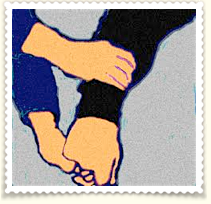I’LL LET YOU KNOW
how close you can come!
PREVIOUS: RIGID Bs (Part 2)
REVIEW: ‘Boundaries Defined’
WHAT are Healthy Bs?
According to L. A Hayduk (1978), it’s “the area each person actively maintains around themselves, into which others cannot intrude without arousing discomfort”. And Richard Stengel (1995) found that ‘Personal Space’ surrounds one’s ego-center, intuitively understood by all human beings
• Setting boundaries is about moderation & grey areas, which requires a person to be “fully differentiated” via S & I. A good boundary-setter is willing to step into their uncomfortable ‘grey zone’ to have a Yes or No line. They know who they are & who they’re not, taking responsibility for what’s theirs, & expecting / allowing others to take responsibility for what’s theirs
• Then 2 such people, already independent, can be inter-dependent, close enough to stay connected with a positive impact on each others’ life, without unwanted intrusion. Bs are flexible enough so people can grow & change. Each can drawn their Bs in to encourage intimacy, or extend them to create safety
• We all react to changes in environment, managing it to suit our unique ‘Comfort Zone’ – with specific rules for what works for us, so there are no absolutes. A severe decrea se in available personal space makes us itchy. If the situation persists, this lack of control can cause psychological distress
se in available personal space makes us itchy. If the situation persists, this lack of control can cause psychological distress
PRIVACY
Social scientist Irwin Altman studied privacy in relation to all forms of Social Boundaries – what makes them optimal, balanced between ‘not too hot & not too cold’!
According to Altman (1975) Bs Are :
1. fluid – we decide how open or closed we are, in reaction what’s going on inside or outside of ourselves
2. not perfect – the amount of space we want or need, to feel comfortable & fulfill a particular role, is often different from what’s available
3. flexible – our invisible Bs adjusts to different situations. With too much privacy (more is not always better), a person will start crowding others, given an opportunity.
With too little privacy, they compensate by isolating
4. 2-way – involves input from others, such as noise -and- output to others, such as talking
5. 2-leveled – individuals vs groups (public places, cyberspace…)
PROXEMICS
In the early 1960s American anthropologist Edward Hall was a pioneers in the study of humans’ spatial needs, coining the word ‘proxemics‘.
A subcategory of non-verbal communication, it’s about the impact it has on social interactions: how we respond to & use our personal space – the distance between ourselves & others.
His research led to a new understanding of the human need for territory (animals do too), divided into:
Personal – the immediate area surrounding individuals. EXP: our body’s space-need & posture are unconscious reactions to subtle changes in sound & pitch of another person’s voice
Territorial – the area people will lay claim to & defend against others IS to “propagate the species by regulating density”
This aspect includes the study of how space is organized in houses & buildings, the layout of towns & cities, & in collective forms such as Clans & Countries.
Some responses to B Invasion:
▪︎ choose less personal topics, talk about leaving, avoid eye contact
▪︎ increase inter-personal distance, turn away, leave
▪︎ AND, as with non-humans when pushed too far – reacting with aggression
Degree of Intimacy: Hall determined type of responses by the “angle formed by the axis of the conversants’ shoulders” – a combination of postures (sitting, standing, prone…), affected by nonverbal factors each picks up from the other:
⚓︎ Kinesthetic – how close people are touching
⚓︎ Olfactory – amount of odor picked up
⚓︎ Thermal – degree of body heat
⚓︎ Touching – ways 2 people are touching, or not
⚓︎ Visual – amount of eye contact
⚓︎ Voice – silent, very soft, soft, normal, normal+, loud, & very loud.
Cultural Factors : Hall noted that Realizing & Recognizing cultural differences helps eliminate discomfort people may feel when their interpersonal distance is too great (“stand-offish”), or too small (intrusive).
 The Lewis Model of Cultural Types suggests 3 styles :
The Lewis Model of Cultural Types suggests 3 styles :
a. “Multi-active” cultures, warm & impulsive (Brazil, Mexico, Italy)
b. “Linear-active” cultures, cool & decisive (Germany, Norway, USA)
c. “Re-active” cultures, accommodating & non-confrontational (Vietnam, China, Japan)
NEXT: Healthy Bs – info (Part 2)

